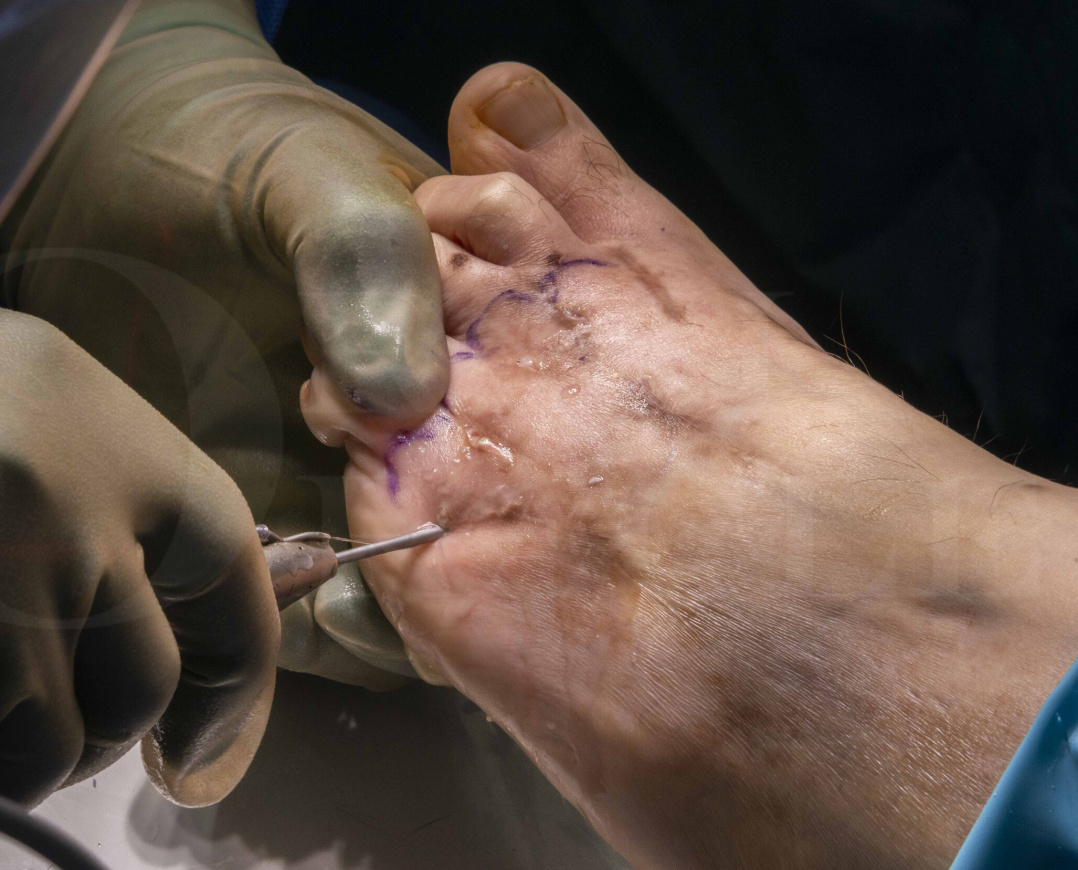Distal Minimally Invasive Metatarsal Osteotomy (DMMO) for Metatarsalgia and Correction of Lesser Toe Deformities
Overview

Subscribe to get full access to this operation and the extensive Foot Surgery Atlas.
Learn the Distal Minimally Invasive Metatarsal Osteotomy (DMMO) for Metatarsalgia and Correction of Lesser Toe Deformities surgical technique with step by step instructions on OrthOracle. Our e-learning platform contains high resolution images and a certified CME of the Distal Minimally Invasive Metatarsal Osteotomy (DMMO) for Metatarsalgia and Correction of Lesser Toe Deformities surgical procedure.
Distal metatarsal osteotomies are in the main used for the surgical treatment of metatarsalgia (which can occur for a number of reason)and the technique results in an altered profile of the distal metatarsal cascade. Specifically the effects include shortening, elevating, and realigning of the metatarsal head in the coronal plane. These osteotomies are particularly and specifically used in the lesser metatarsals to decrease the weight passing through the metatarsal head to the floor and are particularly useful in the treatment of metatarsalgia. Open techniques of performing this operation have been used for many decades, starting initially with the Helal osteotomy and more recently the Weil osteotomy (see indications section for a full discussion of these).
Over the last 25 years or so, surgeons such as Mariano De Prado, Joel Vernoir in Europe and David Redfern, in the UK (formerly in Europe) popularised a minimally invasive technique, to perform an extra-articular distal metatarsal osteotomy (DMMO) . This is predominantly used in the lesser metatarsals, but also has been described for the treatment of hallux rigidus, by performing it on the 1st metatarsal.
The DMMO is an extra-articular minimally invasive technique that requires a degree of skill with minimally invasive instrumentation. The osteotomy is performed just proximal to the flare of the metatarsal head and is extra-articular in nature. It does not require any soft tissue release as in previous open osteotomies. The aim of this osteotomy is to tangentially divide the metatarsal neck, keeping the soft tissues intact. This in turn is then manipulated by the patient by walking on the operated foot, so that the metatarsal inherently finds its ideal position ,where load transfer is uniform. The use of a specialist minimally invasive cutting burr, necessarily results in shortening of the metatarsal, as the burr removes 2-3mm of bone during the process of cutting. By performing the osteotomy tangentially a further effect is elevation of the metatarsal head. The significant bi0mechanical changes that are caused by this shortening osteotomy are instrumental in resolving the problem of metatarsalgia.
The key effects of the DMMO are :
- Decrease in load transfer through the metatarsal
- A resultant decrease in ground reaction forces
- Improved distribution of weight across the metatarsal cascade
- A relaxation of the pressure on the plantar plates which may be responsible for the pain relief experienced by patients
- A realignment of the forces through the collateral ligaments, the flexor and extensor tendons, and possibly the small muscles although this is an extrapolation of the Weil osteotomy studies
The biggest advantage of this osteotomy is that it does not disrupt any of the constraining structures around the metatarsal phalangeal joint, in particular the collateral ligaments and the plantar plate. It also has the major advantage of minimal soft tissue disruption and is particularly useful in patients with poor skin quality and those with a higher risk of soft tissue complications such as diabetes and peripheral ischemia.
The essential knowledge requirements for those performing this operation are:
- An in-depth understanding of the anatomy of the metatarso-phalangeal joint and surrounding structures.
- An intimate knowledge of the workings of the instrumentation required for this procedure.
- A due respect paid to careful maintenance of the integrity of soft tissues.
- An in-depth understanding of the bio-mechanical changes effected by this osteotomy.
- Essential training, including Cadaver course training in the technique.
OrthOracle readers will also find the following associated instructional techniques of interest:
Minimally Invasive Akin osteotomy (Wright Prostep), Claw toe correction and flexor tenotomy.
Weils osteotomy (using Othosolutions forefoot reconstruction system, FRS)
Dorsi-flexing osteotomy of first metatarsal
Author: Kartik Hariharan FRCS
Institution: Aneuran Bevan University Health Board, Wales
Clinicians should seek clarification on whether any implant demonstrated is licensed for use in their own country.
In the USA contact: fda.gov
In the UK contact: gov.uk
In the EU contact: ema.europa.eu
Online learning is only available to subscribers.



















